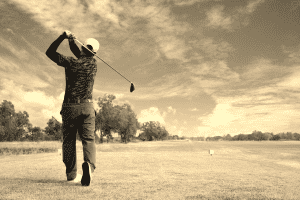How many times have you heard golfers talk about their swing tempo? The game of golf has quite a few abstract concepts and topics, and there is no doubt that the golf swing tempo is one of the most frequently discussed concepts. With that said, many amateur players confuse tempo with swing speed or even stability in the swing.
However, the tempo is its own thing, and if you want to be a great player, you need a great tempo. Many players out there have learned to master golf swing tempo, but it will take a little bit of time and effort on your part.
If you want to develop a consistent tempo like a Freddy Couples or more recently Grant Horvat, you need to put in the work for it.
Here’s everything you need to know about golf swing tempo, so you can emulate that inner Grant Horvat in no time.
What is Golf Swing Tempo?
Golf swing tempo is the amount of time it takes for you to complete a golf swing. From the start of your swing to the finish. However, this pure definition of golf swing tempo does not fully explain why this fundamental has so much of an impact on your swing.
Some golfers can have a very quick tempo, but because of their balance and the distribution of the timing of the swing, the results are great.
Other golfers can have a very slow tempo and struggle to make consistent contact with the ball because the tempo is not balanced properly.
Essentially golfers very often confuse their swing speed with their tempo, and it’s not the correct way to think of this. My favorite way to help golfers understand swing tempo is to think about dancing, something like a waltz.
You know the standard, “1, 2, 3, 1, 2, 3,” that is said during a waltz; this is tempo. If you say 1, 2, 3 too fast, the dance won’t be correct; if you say it too slow, it won’t look like a waltz. The golf swing is the same way.
Why is Swing Tempo So Important?
Swing tempo is incredibly important in the game of golf. If your swing tempo is off, your rhythm and consistency will be off. Essentially, it becomes difficult to repeat your swing. Most golfers then struggle with squaring the clubface up and getting their arms, body, and brain to work together through the shot.
Tempo changes in golf can impact total distance, ball flight, consistency, and, ultimately, your scores. If your swing tempo is not something that you can repeat or have control of, you can’t expect to master other areas of the game.
A great swing tempo can make it much easier for everything to sync up in your golf swing, and produce consistent shots. A bad tempo becomes wildly unpredictable, and will lead to frustration while you’re out playing.
How To Master Your Swing Tempo
Working on swing tempo is not as difficult as some golfers like to make it. In fact, some of my favorite drills are swing tempo drills. My favorite part about these drills is that they bring up other issues in the game and make it considerably easier for me to fix them.
Here are 6 golf swing tempo tips that can help you become a more consistent player.
Stay Relaxed
One of the first ways to work on mastering your swing tempo is to stay a bit more relaxed when you play golf. Tension in the golf game can creep up on you, and it almost always has negative effects.
The grip is the first place to look for tension. So many players forget how much pressure they have in their hands. It builds up over the course of the round, and by the back nine, you are clenching the club as you swing.
Hold the club with enough tension to ensure that you don’t lose it and can aggressively go after the ball. However, if you notice this tension in your hands start to move into your arms, that’s where the real problems develop.
Another area that I have to look for tension in my swing is in the way I setup. Sometimes I get so locked into my setup that I stay there too long. The golf swing is a fluid motion; we have to consider ourselves athletes when we swing; athletes don’t stand there for long and let the tension build-up.
A relaxed setup is the first step towards a silky smooth tempo.
Start Out Low and Slow
The backswing takes longer than the downswing. Golfers that try and make their backswing and downswing the same amount of time will lose a ton of power, rhythm and flow and will struggle to stay consistent.
With the backswing being a little slower, you will not lose any of your forward momentum or any power. In fact, even golf professionals have a much slower backswing than you may think.
One of my favorite things to think about (both for takeaway reasons and tempo) is to keep the club low on the backswing. The low and slow takeaway creates some more extension in the swing and makes it easier to fully finish towards the target.
Nothing bad will come out of this low and slow takeaway. A slower more deliberate takeaway will naturally help you fall into a better swing tempo.
Don’t Rush Your Swing
As I mentioned, some golfers try to slow the tempo down, and it creates issues; others need to learn to slow it down. If you’re looking for a general idea of what the tempo in your swing should be like, you can consider the 1-2-3-1 drill.
With this drill, you will count to three on your backswing; once you get to the top, the rest of the swing from this point on just takes one count. This shows you that the backswing and buildup are quite long, and the rest is about speed.
It takes a bit of time to feel this process, but it certainly helps you get the motion down and realize that this longer and slower backswing is the answer.
Many golfers that are new to the game are looking to create speed. As soon as they pull the clubhead away from the ball, they think it’s speed time.
This is not correct.
Instead, think about this 1-2-3-1 sequence, and you can have a general guideline for what it takes to get from the address position to the full follow-through position.
Feel Your Transition
As I mentioned, it should take much longer to get to the top of the swing, and then the downswing and follow-through are faster. However, some golfers have difficulty feeling this transition from backswing to downswing.
If you are having a hard time feeling the transition, simply learn to pause at the top of your swing.
The pause drill allows you just a brief one second of time to get your body moving towards the downswing and encourage that slower and longer backswing. The pause does not create too many issues as long as it is kept brief.
You can use the pause as a drill, but I’ve also kept it as a swing thought. The pause just helps to settle you down and gives you that feeling of direction in your swing.
Some of the best players in the game look as though they have a pause at the top of their swing. Think of PGA pros like Cameron Young and Hideki Matsuyama, who both hold significant pauses at the top of their swing. Incorporating this style of pause will allow everything in the swing to “gather” and sync up for your downswing.
Stay Balanced
Balance is another important part of a great tempo. If you can keep yourself balanced, expect to get more distance, and have an easier time controlling your tempo.
A few of the ways I’ve used to get myself more balanced have been to cross-train, get great golf shoes, and focus on where my weight is.
Doing some exercise off the course helps tremendously when it comes to balance. In addition, having golf shoes that provide a better connection between the turf and my feet also increases the overall balance in the golf swing.
Finally, when I set up to hit shots, I know my weight is in my feet, but more specifically, where is the weight? Is it on my toes, in my heels, on the outside, the inside, etc.?
Start to work on getting the weight balanced on the feet, and the results will be quite impressive.
Swoosh Drill
Last but not least is the swoosh drill. For this one, you will grip the just under the hosel or the club head of your golf club. I usually do this with something like a fairway wood, as it is lightweight.
I grip the club in this area which is essentially holding the golf club upside down. Next, I take some swings (not hitting a ball). The idea is to hear the golf club make a swoosh noise as late in the swing as possible.
If I hear the swoosh noise as I swing through the impact zone, I know my tempo is quite good, and I’m also working on getting some extra power. The grip end of the club creates quite a bit of resistance and really lets you feel that transition at the top of the swing.
If done improperly, you’ll hear the swoosh too early and know you’re casting or not quite synched up.
The swoosh drill is a great way to warm up before a round of golf.
Final Thoughts
Golf swing tempo is a complicated concept because it’s more about feel than anything else. It’s hard to measure tempo or to come up with an exact formula for it. However, by practicing these tempo drills, you will be well on your way to becoming a better player and having that swing tempo down.
I try to incorporate some golf swing tempo drills into everything I do, whether it be a quick practice before a round or a warmup on the first tee box. The golf swing tempo is easily one of the most important parts of the swing, and will lead to better ball striking and more consistency if done properly.









